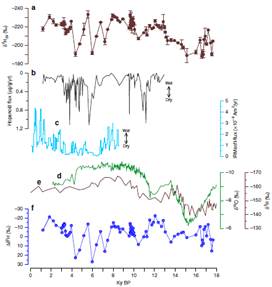Abstract
The nature and extent to which hydrological changes induced by the Asian summer monsoon affected key biogeochemical processes remain poorly defined. This study explores the relationship between peatland drying and carbon cycling on centennial timescales in central China using lipid biomarkers. The difference between peat n-alkane δ2H and a nearby stalagmite δ18O record reveals that intervals of prominent peatland drying occurred during the mid-Holocene. Synchronous with these drier conditions, leaf wax δ13C values show large negative excursions, with the utilization of CO2 respired from the peatland subsurface for plant photosynthesis being a possible mechanism. Crucially, successive drying events appear to have had a cumulative impact on the susceptibility of peat carbon stores to climate change. Concurrently, bacterially derived hopane δ13C values suggest the occurrence of enhanced methane oxidation during the drier periods. Collectively, these observations expand our understanding of how respiration and degradation of peat are enhanced during drying events.
|
 |
|
|
|
|
Comparisons of paleohydrological records. a ZK-5 δ2H29 values. b ZK-3 hopanoid flux12. c IRMsoft-flux in stalagmite HS410. d The calcite δ18O record from Sanbao Cave14. e The C29 and C31 n-alkane weight-averaged δ2H values of SO188-342KL37 over the last 18 ky. f The Δδ2H (between Sanbao Cave carbonate and ZK-5 leaf waxes). Error bars represent 1 s.d. of replicate runs
Title: Response of Carbon Cycle to Drier Conditions in the Mid-Holocene in Central China
Authors: Xianyu Huang, Richard D. Pancost, Jiantao Xue, Yansheng Gu, Richard P. Evershed, Shucheng Xie.
Source: Nature Communications, (2018) 9: 1369
DOL: 10.1038/s41467-018-03804-w
Link to the paper: www.nature.com/naturecommunications